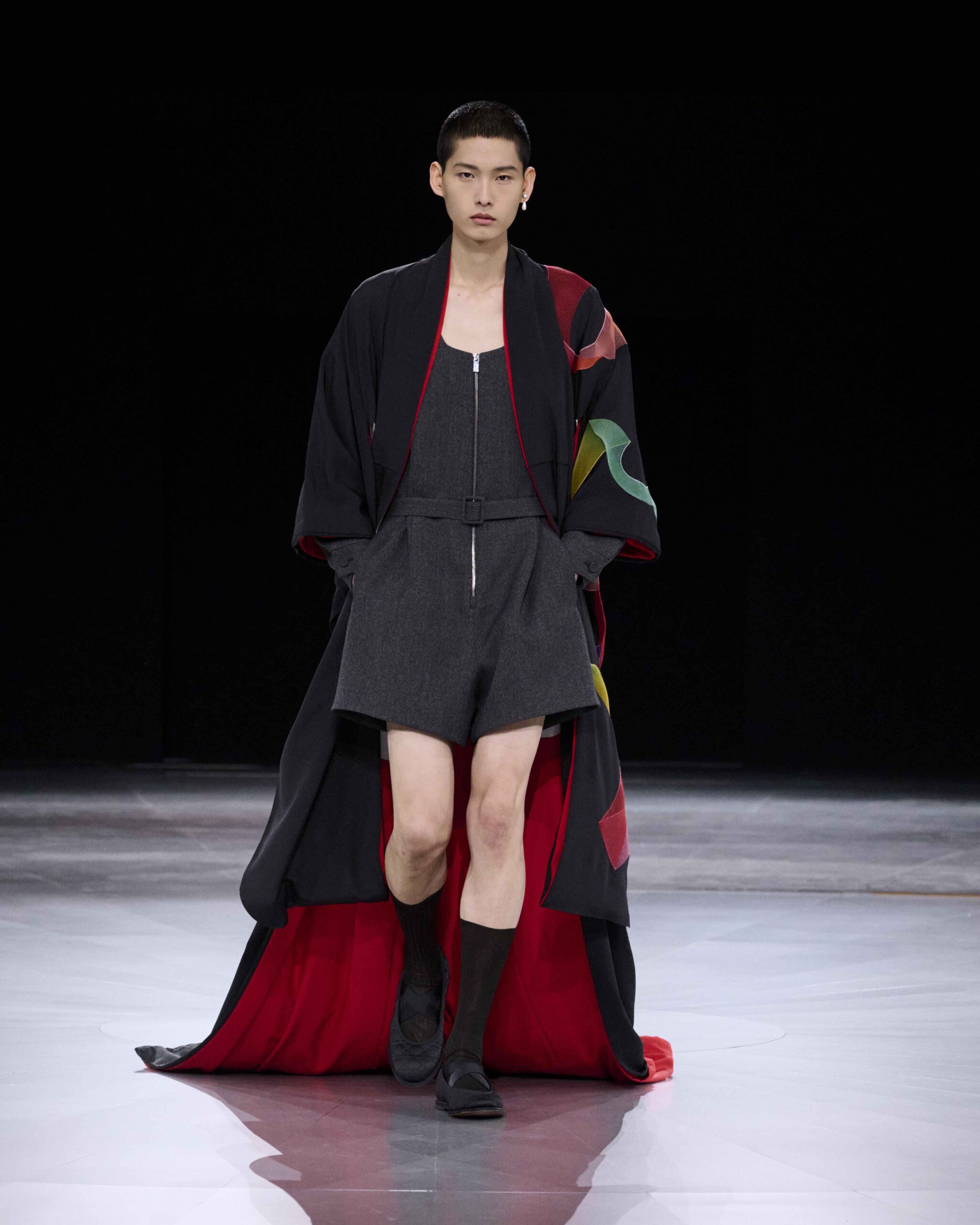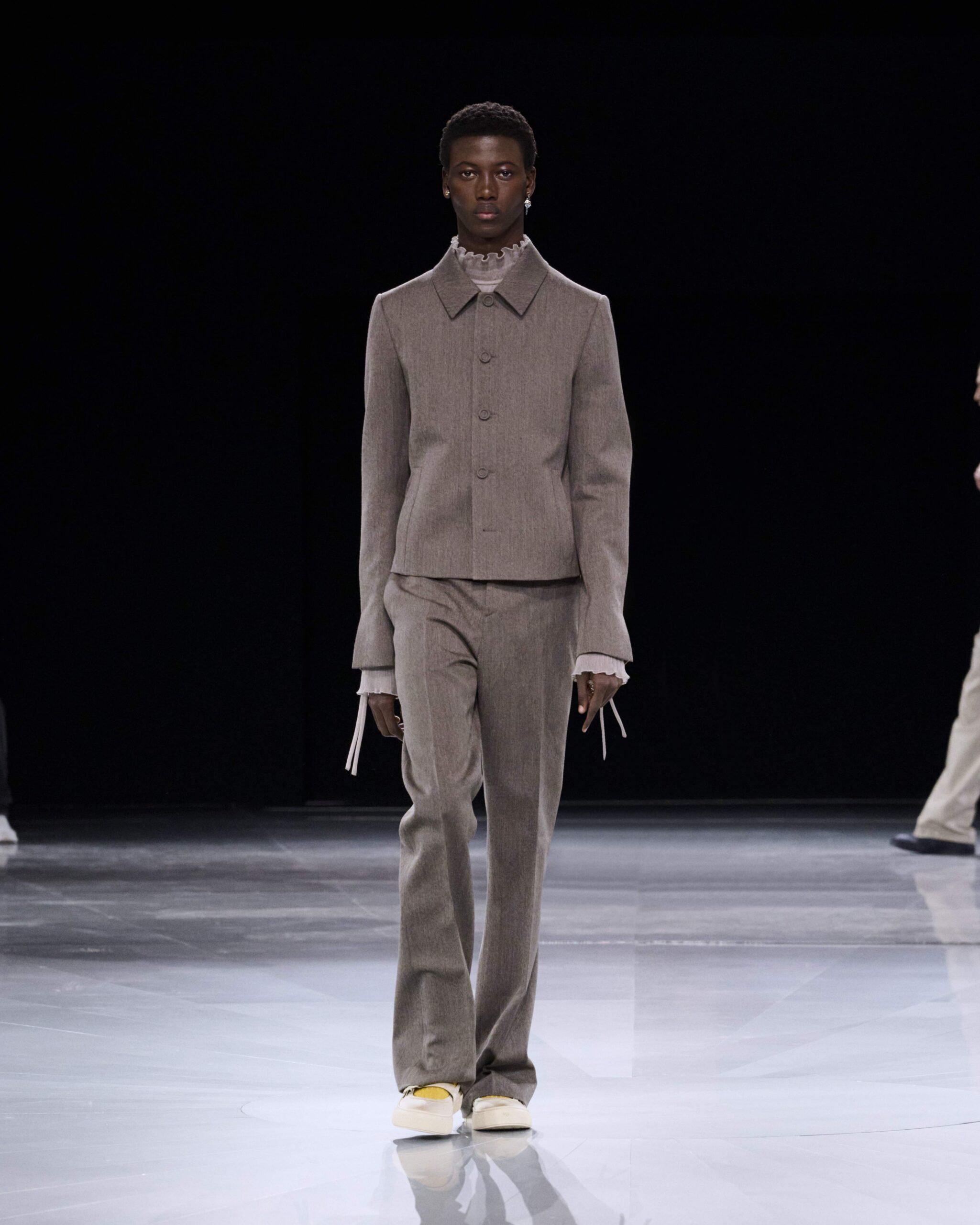Drawing on the rich Dior archive as a source of inspiration, the tailoring mastery of Saint Laurent makes its return to the men’s world, focusing carefully on volumes, slits, folds, and necklines that define the structure. Monsieur Dior’s Bar jacket, the protagonist of a new masculine interpretation, merges with Jones’ Tailleur oblique – an element present since his first Dior collection – characterized by an extended double-breasted front that joins a sinuous waist curve of the Bar jacket. The linear approach of the ’60s and ’70s is evident from the outset, with the simplicity of a single-breasted look paired with delicately flared trousers, all crafted in a subdued suiting fabric of rich mélange wool. Permeated with a sense of timeless sophistication, this collection rediscovers and reinterprets the classic elements of the Dior archive, bestowing upon the male wardrobe a new and modern elegance. The spirit of Rudolf Nureyev, a unique dancer of the twentieth century, guides the entire collection, celebrating the beauty and history of ballet, an occasion for the artistic director to pay a wonderful tribute to his uncle, Colin Jones, a dancer who became friends with the star and also photographed him. Infused with spirit and inspiration, the looks virtuosically reinterpret the dancer’s unique style, with iconic wool shorts with zippers and ribbed knitwear in key pieces with a Montgomery effect. Kim Jones, with skill, has translated the aesthetics and energy of ballet into contemporary men’s fashion. The runway was a choreography of style, a blend of the performing world of ballet and the codes of the Maison. Models walked with the grace and precision of experienced dancers, conveying effortless elegance while wearing garments that seemed to be sculpted with the same precision as a pas de deux.

“Nureyev is intricately linked to my personal history through my uncle, the photographer Colin Jones. Colin, once a ballet dancer, cultivated a friendship with the ballet star and photographed him. The collection, or rather, collections, revolve around the theme of contrast: the disparities within the House of Dior in terms of ready-to-wear and haute couture.”
In the first part, everything recalls leotards, jerseys, ballet shoes, berets, and scarves to cover the head, and on the other hand, the Dior Haute Couture collections, with many references to those signed by Yves Saint Laurent. This dual vision is reflected in the soundtrack that sets the pace for the runway: Sergei Prokofiev’s Romeo and Juliet – music danced by Fonteyn and Nureyev together; here, the Dance of the Knights loops in a rewriting by Gerhard Richter. Along with sumptuous leathers, the world of couture reflects the extravagance of stage presence, ostentation, insolence, and the elegance of Nureyev, sometimes reflecting his private passion for collecting antique fabrics. This aspect is particularly evident in the kimonos that leverage ancient manual techniques practiced by Japanese master craftsmen. The silver Uchikake kimono, with its prestigious Hikihaku weaving technique, is based on a garment owned and worn by Nureyev, a piece that takes three months to complete. In couture, archive embroideries stand out, especially those of the Debussy dress, a spectacular creation conceived by Monsieur Dior in 1950 and worn by Margot Fonteyn, here reinvented in a masculine iteration. Accessories recall the simplicity, discipline, and extravagance of the two worlds, sometimes in a contemporary way. An example is the dance slipper that draws from male eveningwear traditions, contrasting with a silk-polyester Mary-Jane sneaker in the shoes. Softly constructed utility bags amplify the maison’s codes, like camera bags and oversized macrocannage pouches. Sumptuous velvet hats, originally designed by Stephen Jones in 1999 for Dior women’s fashion, now take on a masculine form as ballet turban in twisted silk jersey.
“I wanted to represent the difference between what happens on stage and behind the scenes; the theatricality and the reality of Nureyev’s life. Essentially, it’s a meeting between the style of the dancer and that preserved in the Dior archives.”
The presence of Rudolf Nureyev’s spirit is evident in the folds and empty spaces that dance on the fabrics. Volumes are masterfully balanced, creating a harmonious equilibrium between structure and fluidity. Necklines are strategically placed to add a touch of sensuality, emphasizing the male silhouette. The color palette, inspired by the theater stage’s palette, ranges from neutral and subdued tones to bolder shades of red and blue, echoing the emotions and intensity of ballet. Accessories, crafted with the same attention, complete the looks with elegant belts, refined shoes, and details that evoke the world of dance. The finale takes place on a double round and revolving runway where the inner circle rises to an upper level like a music box: an effect that assumes the meaning of triumph and memory, the designer’s staged thought and history are deeply intrinsic to art and love, it is an intense dedication to the memory of Colin Jones and his brother Michael, Kim’s father.
















